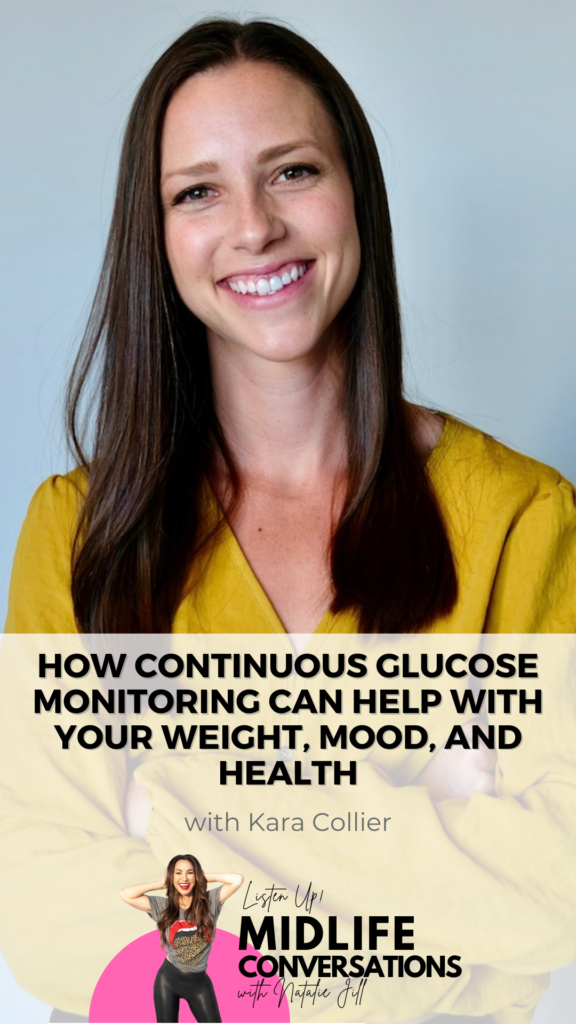How Continuous Glucose Monitoring Can Help with Your Weight, Mood, and Health with Kara Collier
👉 Get started with Nutrisense – Use the code ‘NatalieJill25‘ for a discount when you get started!

I was SO looking forward to this interview because I’ve had a love/hate relationship with continuous glucose monitors (CGM)…if you’ve been following me…you know! BUT, I DO think there is a huge place for them to aide us in our health if used mindfully and responsibly in terms of preventative care. She was inspired to focus on this because during her time spent as a nutritionist in the ICU, about 80-90% of the patients she was seeing, were in there due to lifestyle related complications (from diabetes to hypertension, etc.) A lot of the time, it was simply too late to fix things that could have been prevented.
It’s also really important for me to share with you that you don’t have to LOOK the part to have blood sugar problems. I am a completely healthy weight, healthy BMI, healthy diet…and MY markers actually showed me as pre-diabetic! I was able to address this BY wearing a continuous glucose monitor and really dialing in my numbers. Within 4 weeks I was able to REVERSE my pre-diabetic markers! It’s important I share this with you because MOST doctors are NOT sharing this information with you. It IS possible.
How Big of an Issue is Blood Sugar?
Blood sugar is a HUGE issue. Right now we can estimate that close to 1/3 of people have either pre-diabetes or diabetes — but this isn’t even capturing the full picture. Metabolic health can be diagnosed in a traditional way by looking at 5 factors:
- Glucose
- Weight
- Triglycerides
- Hypertension
- HDL
We know that close to 90% of Americans are NOT metabolically healthy, which means they have one or more of these out of the normal range. Looking at metabolic health as a whole, the statistics look pretty grim. By the time you get to Diabetes Type 2 diagnosis, it’s been in progress for a long time that if caught early enough, can be reversed. It’s important to know that not everyone “looks” the part of this…this can all be happening inside of us despite how we might look on the outside (aka…you don’t have to look extremely overweight for this to be an issue!)
Is Looking at A1C Doing a Good Enough Job?
No. When we look at A1C, we are seeing a delayed result, measuring your average glucose over the last three months. An average doesn’t tell you everything you need to know. Two people can have the same average, but one might always sit at a stable steady number while the other has huge spikes and dips that “averages” to the same number. This is important to know. Also, it measures how much sugar has been stuck to your red blood cells over the past three months. This is a problem because although the average lifespan of red blood cells is 90 days, some peoples red blood cells last longer or die faster which skews the result of the A1C labs. Almost 40% of A1C values do not match the actual glucose level! You can actually have a normal A1C level and a normal fasted glucose level, but still have some abnormal readings on a CGM.
Are CGM Readings Accurate?
Across ALL brands of CGMs, there is a “buffer” for accuracy. While they are approved by the FDA, they are allowed to have about a 15% variation 95% of the time. This IS different from what you get from a lab value. An important difference to make is precision vs. accuracy. The exact number might be different, but the change in glucose numbers, is very precise.
What Should a HEALTHY CGM Reading Be?
If you Google this, you’re going to see metrics for diabetics. But here we are talking about non-diabetics. We need to look at what happens in a fasted state and what happens after you eat a meal.
Fasted: 8 hours without food; non-diabetic glucose values should be less than 100. However, the optimal number should be 70-90.
After a meal: the questions to consider how high does it go and how long does it take to come back to normal values? Ideally, peak glucose is under 140.
If it goes, say, to 200 after you eat jellybeans…it doesn’t mean you’re pre-diabetic. It just means there is something wrong, and it’s a great time to start making adjustments and intervene to prevent something from getting worse in the future. A lot of the daily symptoms you’re writing off, can definitely be related to constant high blood sugar problems. Once you learn your blood sugar, you are able to eat more intuitively and what your body is telling you.
How Does Nutrisense Work?
A CGM lasts 14 days and the plans all include 2 CMGs. You can decide how long you want to do it — from a month to however long. You sign up on Nutrisense, you can get the device without the subscription, they ship the device, you put them on at home, leave it on for 2 weeks, and use the app to monitor the results. You can learn so much about yourself that you’d never know without having the DATA. It will also help you understand your daily symptoms and how YOU personally respond to glucose. There is not at all one size fits all for people, as each body is unique. “You can’t manage what you can’t measure!” Every plan comes with dietician support to help navigate results and answer your questions.
This and MORE on this episode!
👉 Get started with Nutrisense – Use the code ‘NatalieJill25‘ for a discount when you get started!
About Kara Collier
Kara is a Co-Founder of Nutrisense and a Registered Dietitian Nutritionist (RDN), Licensed Dietitian/Nutritionist (LDN), and Certified Nutrition Support Clinician (CNSC) who specializes in glucose control and metabolism. She graduated from Purdue University and previously worked at Memphis VA Medical Center, as a clinical dietitian at Providence Hospital, and in a management role at Nutritionix.
In this episode, you will learn:
- How big of an issue are blood sugar issues?
- 90% of Americans are NOT metabolically healthy
- The issue with just checking A1C
- Are CGMs taking anything away from true diabetics?
- How accurate are CGMS compared to actual readings?
- How common or uncommon is hypoglycemia?
- What is “reactive” hypoglycemia?
- Why does your body sometimes over correct with insulin?
